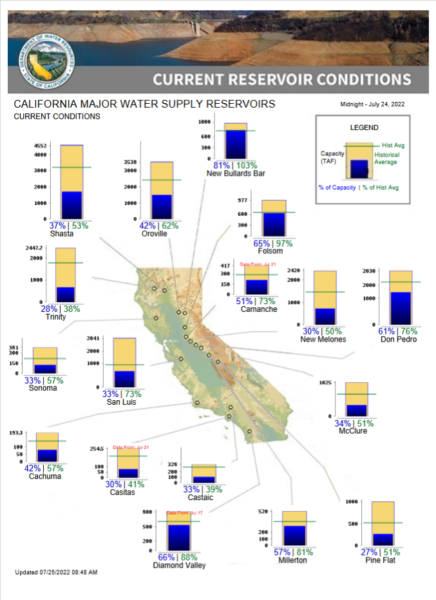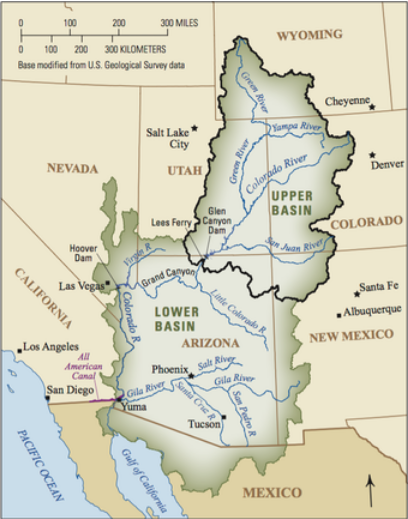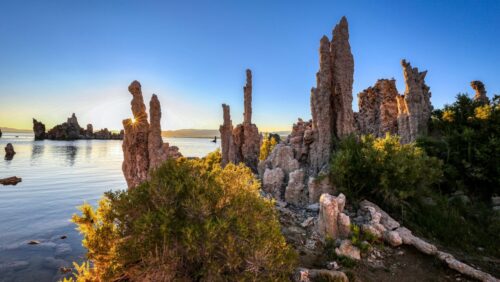On the calendar today …
- PUBLIC WORKSHOP: State Water Board’s Racial Equity Action Plan: Mecca/Zoom from 4:30pm to 6:30pm. The State Water Board invites you to attend a workshop to learn about our ongoing racial equity efforts and to join us in developing a Racial Equity Action Plan. Please help us create a future where we preserve, protect, and restore drinking water and water resources for all Californians, and where race is not a predictor of professional outcomes for Water Boards employees. Attend in Mecca or via Zoom. Click here to register.
In California water news today …
Here’s how low California’s reservoirs are and what to expect in the future
 “Here’s a look at the status of California’s reservoirs during another drought: There has not been much good news about California’s water supply lately, but there could be some relief on the way. The North-of-Delta Offstream Storage project, often referred to as the planned Sites Reservoir, was authorized by Congress in 2003. The long delayed project got a financial boost in March when the federal government signaled its intent to loan the project nearly $2.2 billion — about half of the cost to design, plan and build it. … ” Read more from the San Jose Mercury News here: Here’s how low California’s reservoirs are and what to expect in the future
“Here’s a look at the status of California’s reservoirs during another drought: There has not been much good news about California’s water supply lately, but there could be some relief on the way. The North-of-Delta Offstream Storage project, often referred to as the planned Sites Reservoir, was authorized by Congress in 2003. The long delayed project got a financial boost in March when the federal government signaled its intent to loan the project nearly $2.2 billion — about half of the cost to design, plan and build it. … ” Read more from the San Jose Mercury News here: Here’s how low California’s reservoirs are and what to expect in the future
Why has agriculture been so slow to embrace the use of grey water?
“The clean water that washes over hands in sinks, spinning down the drain just fractions less pure than what came from the tap; laundry water that pumps into waste pipes by the gallon from households every day; water draining out of a tub that was safe enough for bathers to soak in. That water—slightly used but not fully soiled—is called grey water. And in an increasingly drought-stricken world, it may be the best tool to have in your water conservation toolbox. … Despite its many benefits, grey water’s potential largely remains untapped. This is mainly due to inconsistent regulations state by state, differing plumbing codes and systems, as well as a general lack of education. … ” Read more from Modern Farmer here: Why has agriculture been so slow to embrace the use of grey water?
Nothing icky about ‘toilet-to-tap’: water recycling explained
“Wastewater that recently swirled down a toilet bowl may be coming to your tap, in purified form, especially if you’re in a drought-stricken area where drinking water is increasingly scarce. More municipal water systems in the West are considering water recycling, known in some places as “toilet-to-tap.” And Congress may begin supporting the idea as water systems scramble to find secure water supplies amid a decades-long drought driven by climate change, which may be the worst the region has experienced in more than a millennium. Here’s a look at the context for a national discussion about water recycling, how it’s regulated, and what’s at stake. … ” Read more from Bloomberg here: Nothing icky about ‘toilet-to-tap’: water recycling explained
Follow the water
Jay Lund writes, “People often have strange ideas about how water works. Even simple water systems can be confusing. When water systems become large complex socio-physical-ecological systems serving many users and uses, opportunities for confusion become extreme, surpassing comprehension by our ancient Homo sapien brains. When confused by conflicting rhetoric, using numbers to “follow the water” can be helpful. The California Water Plan has developed some such numbers. This essay presents their net water use numbers for 2018, by California’s agricultural, urban, and environmental uses by hydrologic region. Net water use is the amount by which a water use deprives water from other uses. … ” Read more from the California Water Blog here: Follow the water
Drought in western US forces ranchers to sell cows at fastest pace in decade
 “Severe drought conditions in the West are forcing ranchers to sell their cow herds at a pace not seen in a decade — a development that may cut beef prices in the near term but send them higher next year, analysts say. Cattle ranchers in California, New Mexico and parts of Colorado have been particularly hard hit by drought-parched grasslands and are culling their herds, selling to ranchers further East or to feedlots where cattle are taken to be fattened up before they are slaughtered. The most recent heatwave affecting 80% of the Western region brought the drought to a boiling point, according to America Farm Bureau Federation. … ” Read more from the New York Post here: Drought in western US forces ranchers to sell cows at fastest pace in decade
“Severe drought conditions in the West are forcing ranchers to sell their cow herds at a pace not seen in a decade — a development that may cut beef prices in the near term but send them higher next year, analysts say. Cattle ranchers in California, New Mexico and parts of Colorado have been particularly hard hit by drought-parched grasslands and are culling their herds, selling to ranchers further East or to feedlots where cattle are taken to be fattened up before they are slaughtered. The most recent heatwave affecting 80% of the Western region brought the drought to a boiling point, according to America Farm Bureau Federation. … ” Read more from the New York Post here: Drought in western US forces ranchers to sell cows at fastest pace in decade
Tire dust: the ‘stealth pollutant’ that’s becoming a huge threat to ocean life
“For decades, coho salmon returning from the Pacific Ocean to the creeks and streams of Puget Sound in Washington state to spawn were dying in large numbers. No one knew why. Scientists working to solve the mystery of the mass deaths noticed they occurred after heavy rains. Toxicologists suspected pesticides, as the main creek they studied ran through a golf course. But no evidence of pesticides was found. They ruled out disease, lack of oxygen and chemicals such as metals and hydrocarbons. The first real breakthrough happened when they tested actual runoff collected from a nearby road and exposed test salmon to it. The fish died within hours. … It was when they tested car tyre particles – a poorly understood yet ubiquitous pollutant – that they knew they were on the right track. ... ” Read more from The Guardian here: Tire dust: the ‘stealth pollutant’ that’s becoming a huge threat to ocean life
These maps show severe fires are morphing California forests into something we won’t recognize
“Many of the largest wildfires in recent U.S. history have happened in California just in the past few years, including last year’s Dixie Fire, which burned nearly a million acres across four counties. Seven others in 2021 achieved “megafire” status, surpassing the mark of 100,000 acres burned. No megafires have occured in 2022 yet, but the ongoing Oak Fire, which started on July 22, has already burned more than 14,000 acres and continues to grow. But size, it turns out, isn’t all that matters, according to fire experts. By itself, it’s a poor indicator of fire’s actual impact. “Forests in California have been burning forever,” said Scott Stephens, co-director of Berkeley Forests at UC Berkeley and wildland fire science professor. … ” Read more from the San Francisco Chronicle here: These maps show severe fires are morphing California forests into something we won’t recognize
Drought-parched California burns while prospects for federal climate action dim
“Over the past six months, prospects for serious federal action on climate change have dimmed. Sen. Joe Manchin (D.-W.V.), a literal coal baron, wields de facto veto power over federal legislation, and he has repeatedly used it to whittle down and ultimately kill President Joe Biden’s once-ambitious climate agenda. Reeling in the polls, Biden himself has declined to publicly hector Manchin to change course, instead busying himself boasting about falling gas prices and pleading with Saudi Arabia to ramp up oil production. With the midterm elections—and the real possibility of losing Democratic control of Congress—looming in November, the president declined to declare a formal climate emergency, as several prominent Democratic politicians had urged him too. Instead, he vaguely promised executive action “in the coming weeks.” … ” Read more from Mother Jones here: Drought-parched California burns while prospects for federal climate action dim
California hopes to fight global warming by pumping CO2 underground. Some call it a ruse
“It’s an emerging technology that climate experts say can prevent billions of tons of greenhouse gases from entering Earth’s atmosphere. By capturing carbon dioxide as it spews from oil refineries, power plants and other industrial smokestacks and then forcing it deep underground for storage, humanity can reduce fossil fuel emissions while developing alternative energy sources, advocates say. Now, as California attempts to meet ambitious climate goals, environmental officials are embracing carbon capture and storage, saying the state cannot achieve carbon neutrality without it. But as officials prepare to finalize a state climate plan that relies on CCS technology, some environmentalists are urging officials to abandon the idea. Instead of helping to wean California off fossil fuels, they say CCS will actually increase oil production. … ” Read more from the LA Times here: California hopes to fight global warming by pumping CO2 underground. Some call it a ruse
Billionaire Tom Steyer bets on weather stations to battle climate
“Solar-powered weather stations that beam real-time information to farmers are the first investment for Galvanize Climate Solutions, the firm launched last year by billionaire Tom Steyer and Katie Hall to battle climate change. Galvanize led a $40-million funding round for San Francisco-based Arable, whose weather equipment gives farmers information on how much sunlight and water crops are getting, and can help optimize when to irrigate or fertilize. Such visibility is becoming increasingly important amid tight on-farm labor and with drought shrinking water reserves. “There’s so many different things we need to do better in agriculture in terms of both using the land more productively, but also using water, fertilizer and pesticides much more carefully,” Steyer said in a phone interview. … ” Read more from Bloomberg here: Billionaire Tom Steyer bets on weather stations to battle climate
In commentary today …
Want to fight climate change and drought at the same time? Bring back beavers
Chris Jordan, mathematical biology and systems monitoring program manager at NOAA Fisheries’ Northwest Fisheries Science Center, and Emily Fairfax, an assistant professor of environmental science and resource management at Cal State Channel Islands, write, “Millions of highly skilled environmental engineers stand ready to make our continent more resilient to climate change. They restore wetlands that absorb carbon, store water, filter pollution and clean and cool waters for salmon and trout. They are recognized around the world for helping to reduce wildfire risk. Scientists have valued their environmental services at close to $179,000 per square mile annually. And they work for free. Our ally in mitigating and adapting to climate change across the West could be a paddle-tailed rodent: the North American beaver. ... ” Read more from the LA Times here: Want to fight climate change and drought at the same time? Bring back beavers
In regional water news and commentary today …
Butte County Supervisors to get latest water updates
“As the California drought continues to impact agriculture as well as the lives of residents, local government bodies have requested regular updates on water resources. Once again, the Butte County Board of Supervisors will hear the latest updates regarding the drought, groundwater and water-related activities within the county. In December, the board contracted Luhdorff and Scalmanini Consulting Engineers to create an analysis of drought impacts on the county in 2021. “It was anticipated that based on the study’s findings, the Drought Task Force and the Water Commission would then identify recommendations for the Board of Supervisors to consider in response to the continued drought emergency in 2022 and to plan for future drought resiliency,” said a staff report from Butte County Water and Resource Director Kamie Loeser. … ” Read more from the Chico Enterprise-Record here: Butte County Supervisors to get latest water updates
High cyanotoxin levels raise concerns for individual private intakes that draw water from Clear Lake
“Health and tribal officials are reporting that, due to persistent drought and heat, they are finding unprecedented levels of cyanotoxins in some areas of Clear Lake. For Lake County residents with individual water systems that draw water directly from the lake using a private intake, drinking water may become unsafe when high levels of toxins are present, Lake County Health Services reported. Of particular concern are those with individual water systems who live around the Sulphur Bank Mine, and along the shore of Clear Lake’s Lower and Oaks Arms. Similar to last year, potentially harmful concentrations of cyanotoxins have been identified in these areas of the lake. … ” Read more from the Lake County News here: High cyanotoxin levels raise concerns for individual private intakes that draw water from Clear Lake
Toxic algae found in Russian River and Spring Lake
“Mid- and late summer is the time when algae blooms appear, bringing the threat of toxicity to families hoping to enjoy the water. That’s going on right now in Sonoma County, where there are good algae and toxic algae. It’s important to know the difference as the summer gets hotter and the algae blooms get bigger. Warning signs are posted along the Russian River at 10 beaches. They warn about potentially toxic algae sighted from near Healdsburg to the lower Russian River. … ” Read more from KTVU here: Toxic algae found in Russian River and Spring Lake
Water has always posed a challenge for Santa Maria Valley
“From the time when the pioneers first arrived, water, or the lack of it, was a major problem for the valley. The first water system was started by Reuben Hart, who came to the United States from Derbyshire, England, first settling in New Jersey with his brother, Thomas. The two brothers came to California in 1866. After working in San Jose for a time, the two moved to Castroville. In 1872 they moved their business again, this time to Guadalupe where they established a blacksmith and machine shop. In 1875 Reuben left Tom in Guadalupe and moved to Central City (Santa Maria’s previous name) to engage in lumber, blacksmithing and carriage making. During that time, he drilled one of the first wells in this area and operated the town’s first water works. As a sideline, he also bought windmills and tanks and sold them to surrounding ranchers for them to use as water systems of their own. … ” Read more from the Santa Maria Times here: Water has always posed a challenge for Santa Maria Valley
Tehachapi: Two water board directors respond to criticism from city, Golden Hills
“Contentious comments by representatives of the city of Tehachapi and Golden Hills Community Services District have been made at meetings of the local water board for a number of months. Generally, board members don’t respond. But at the July 20 meeting of the Board of Directors of Tehachapi-Cummings County Water District, some directors didn’t hold back. Responding to comments from Susan Wells, general manager of Golden Hills CSD, water board President Robert Schultz said, “I wrote my own statement for today regarding the continual comments. So, just because you are a squeaky wheel does not mean that your statements are correct. You stand in front of this board month after month with the same request and attempt to condemn this agency for not acting in your favor. But you are not the only customer for this water. And you most definitely do not represent the feelings of many stakeholders, both within and outside your services district. … ” Read more from the Tehachapi News here: Two water board directors respond to criticism from city, Golden Hills
Buena Vista Lagoon project gets $1 million from state
“State Fish and Wildlife Department officials have awarded a $1 million grant to the San Diego Association of Governments for planning the restoration of the Buena Vista Lagoon at the Oceanside-Carlsbad border. The $1 million announced last month comes on top of $3 million the state Wildlife Conservation Board awarded in December to SANDAG, which oversees planning and contracting for the proposed cleanup of the stagnant 220-acre lagoon. The new grant gives the agency about half the money it needs to finish the engineering and design work that must be completed before the project can be offered for construction bids. … ” Read more from the San Diego Union-Tribune here: Buena Vista Lagoon project gets $1 million from state
Along the Colorado River …
The Colorado River drought is the first climate disaster the U.S. legally has to deal with
 “The Colorado River is dying. The water source for 40 million people across seven states and part of Mexico is rapidly drying out, leaving the two biggest reservoirs in the U.S. thirstier and thirstier, and offering up what may be the first climate change impact that the country literally cannot ignore. “We really don’t have a choice to fail on this,” said Christopher Kuzdas, a senior water program manager with the Environmental Defense Fund. “We’ve got to come together and find a way to manage and govern the system differently under climate change or there’s going to be catastrophic consequences for the Southwest, and I’m not overstating that.” It’s also one of the rare climate disasters that government officials will be legally required to address if current trends continue. … ” Read more from The Grid here: The Colorado River drought is the first climate disaster the U.S. legally has to deal with
“The Colorado River is dying. The water source for 40 million people across seven states and part of Mexico is rapidly drying out, leaving the two biggest reservoirs in the U.S. thirstier and thirstier, and offering up what may be the first climate change impact that the country literally cannot ignore. “We really don’t have a choice to fail on this,” said Christopher Kuzdas, a senior water program manager with the Environmental Defense Fund. “We’ve got to come together and find a way to manage and govern the system differently under climate change or there’s going to be catastrophic consequences for the Southwest, and I’m not overstating that.” It’s also one of the rare climate disasters that government officials will be legally required to address if current trends continue. … ” Read more from The Grid here: The Colorado River drought is the first climate disaster the U.S. legally has to deal with
Reducing consumptive water use must be our main focus to safeguard Southern Nevada’s economic stability
Nat Hodgson, CEO of the Southern Nevada Home Builders Association, writes, “I have lived in Las Vegas and have worked in the development industry for 30 years. Since day one, water has been an important issue. The current volume of Lake Mead compared to years prior is clear evidence there is a serious water issue. Residents, businesses and all those who depend on the Colorado River should be paying close attention to the facts and focusing on conservation policies that will help ensure we utilize our water in the most responsible way possible to preserve our future. As many concerned citizens understandably fear for what’s in store for our future, I believe it to be extremely important we remind the public of the many policies and safeguards that have existed for a very long time. … ” Read more from the Nevada Independent here: Reducing consumptive water use must be our main focus to safeguard Southern Nevada’s economic stability
“Not here for some agrarian fantasy”
“The desert can be surprisingly, well, green in places. Life blooms with the smallest pool of water. And when you’re driving down the highway in Southern Arizona, sometimes you’ll drive right through a field so green, you’d think you were in Coastal California. Anastasia Rabin owns a small farm in a desert community and said it’s a lot to expect farmers to make big, expensive changes without knowing if people will ultimately buy it. “Largely, they’re growing what they’re growing because not only is there a guaranteed market for it, but there are guaranteed subsidies for it, if it doesn’t go well,” Rabin said. She said she’d like nothing more than to be part of a sustainable food culture, but it’s hard for her to see a way to make that possible. Arizona is built on agriculture, from small farms to huge operations. And as resources dwindle, the industry is adapting, and weighing how much it can afford to change. … ” Read more from Arizona Public Media here: “Not here for some agrarian fantasy”
Corporation panel offers Rio Verde a choice
“The Arizona Corporation Commission has waded into the water shortage crisis in the Rio Verde Foothills area. Arizona Corporation Commissioner Anna Tovar sent a letter July 12 to Rio Verde Foothills residents asking them if they would prefer creating a domestic water improvement district or a stand pipe that would allow water hauling to continue. Those in the area opposing the district hailed Tovar’s letter, which stated: “I understand there are several PCSs (public service corporations) near the community that might be interested in providing standpipe service to Rio Verde. If the majority of the community would like to be served by a standpipe, perhaps one of those PCSs will step forward to assist.” … ” Read more from the East Valley Tribune here: Corporation panel offers Rio Verde a choice
Mesa braces for big water cuts in 2023
“New action announced by the federal government in June to keep water levels above critical levels in Lakes Powell and Mead may result in serious cuts to water supplies in Arizona cities beginning in 2023 – including Mesa. That’s earlier than many local water managers expected to see big hits to allocations from the Colorado River, even after alarming reports in April that a 23-year drought and warming temperatures were dropping reservoir levels faster than predicted. In May, Mesa water officials told City Council they were anticipating a 4% reduction in Colorado River allocations for next year, which is just 2% of overall city supplies. … ” Read more from the East Valley Tribune here: Mesa braces for big water cuts in 2023
States mull unpleasant options as feds demand huge cuts on Colorado River
“Colorado, New Mexico, Utah and Wyoming may face requests for voluntary cutbacks in their use of Colorado River water next year, as the federal government eyes releasing more water from Flaming Gorge Reservoir and as Arizona, California and Nevada scramble to find ways to slash water use quickly. Experts say these actions are among dozens of options likely to be on the table as negotiators race to find ways to help rescue lakes Powell and Mead, whose levels continue to drop in the midst of another desperately dry drought year. Last month, U.S. Bureau of Reclamation Commissioner Camille Touton gave the seven states that share the Colorado River 60 days to come up with a plan to cut water use by 2 million to 4 million acre-feet next year and going forward to keep the system from collapsing. Touton asked for a plan from the states on or before Aug. 16. … ” Read more from the Colorado Springs Gazette here: States mull unpleasant options as feds demand huge cuts on Colorado River
Colorado River strain casts shadow over recreation
“On Colorado’s largest body of water, the water he’s known all his life, Eric Loken drives his boat toward an uncertain destination. He drives between the sage hills folding around Blue Mesa Reservoir, between the ancient, volcanic cliffs and toward the high peaks that he and everyone else in this valley look to for snow that translates to water. Lately, they’ve looked on longingly. Loken drives not knowing how far the lake will last. “I’m not sure how far up it goes when it’s this low,” he says. On this morning in early summer, Blue Mesa is about 60 feet lower than normal. It’s not 50% full. … ” Read more from the Colorado Springs Gazette here: Colorado River strain casts shadow over recreation
Does the Upper Colorado River Basin routinely take shortages in dry years?
John Fleck, Eric Kuhn, and Jack Schmidt write, “As stakeholders negotiate the current crisis on the Colorado River, we believe the representatives of the states of the Upper Basin – our states – are making a dangerous argument. Their premise is simple. With deep cutbacks needed, the Upper Basin states argue that their part of the watershed already routinely suffers water supply shortages in dry years. Without the luxury of large reservoir storage along the rim of the watershed that might store excess runoff in wet years and supplement supplies in dry years, the argument goes, the Upper Basin is limited by the actual mountain snowpack in any given year. This is certainly true in many places. One of us (Fleck) lives in a community (Albuquerque, New Mexico) that has routinely seen supplies of trans-basin San Juan-Chama Project water shorted because of bad hydrology in a given year. … ” Read more from the Inkstain blog here: Does the Upper Colorado River Basin routinely take shortages in dry years?
In national water news today …
Republicans oppose drought, wildfire package
“The House will vote this week on legislation to boost wildfire fighter pay, make federal forests more fire resilient and help communities in the West conserve water in the face of long-term drought. The package, called the “Wildfire Response and Drought Resiliency Act,” combines 48 previously introduced bills on related issues, a move that sparked Republican complaints that majority Democrats are trying to ram them through with scant consideration and little GOP involvement (E&E Daily, July 21). While many of the concepts in the legislation, such as enhanced pay and benefits for wildland firefighters, have bipartisan support, Republicans found little to praise at a House Rules Committee meeting Friday that set the parameters for floor debate. ... ” Read more from E&E News here: Republicans oppose drought, wildfire package
Spending bill with $11.5 billion for EPA passes in House
“Last week, the U.S. House of Representatives passed a six-bill spending package for fiscal year 2023, one of which is a $44.8 billion FY 2023 Interior-EPA spending bill that would fund EPA with $11.5 billion. The EPA funding included in the larger bill remained the same as approved by the House Appropriations Committee earlier this month. The funding levels proposed for EPA water programs remained the same as the subcommittee’s initial version of the bill. According to the Association of Metropolitan Water Agencies (AMWA), some key provisions of the Interior-EPA spending bill include … ” Read more from Water Finance & Management here: Spending bill with $11.5 billion for EPA passes in House
SCOTUS could exclude waterways from clean water protections
“A coalition of groups focused on water rights filed a brief in June with the U.S. Supreme Court in an effort to keep the court from narrowing the definition of federally protected waters. Waterkeeper Alliance, San Francisco Baykeeper, Bayou City Waterkeeper, and nearly 50 additional Waterkeeper groups from across the country filed an amicus brief with the Supreme Court in support of the U.S. Environmental Protection Agency in the case Sackett v EPA. The clean water advocates are asking the Supreme Court to uphold the Ninth Circuit Court of Appeals ruling about the scope of wetlands protected under the landmark Clean Water Act. … ” Read more from the Public News Service here: SCOTUS could exclude waterways from clean water protections
EXPLAINER-What’s causing the recent U.S. heat waves?
“Much of the United States will experience another heat wave this week, with above-normal temperatures forecast for the Pacific Northwest, Southern Plains and the Lower Mississippi Valley. The extreme heat is fueling a fast-moving California wildfire, just went of Yosemite National Park. The Oak Fire has destroyed 10 structures and is 10% contained. The U.S. heat wave followed record heat that killed hundreds if not thousands of people and sparked wildfires in Europe. Following is an explanation of what is causing the heat waves, according to scientists. ... ” Read more from Succesful Farming here: EXPLAINER-What’s causing the recent U.S. heat waves?
More news and commentary in the weekend digest …
This weekend in California water news …
-

Photo by Mick Haupt on Unsplash Mono Lake was supposed to have been saved from going dry. Now, the ‘white stuff’ forces a reckoning
- DWR: Delta Conveyance: A fresh look yields a new project
- Water savings from audits, better tech, adding up
- USTMA maintains support for California Department of Toxic Substances Control (DTSC) proposed rulemaking for alternatives analysis for critical tire safety additive 6ppd
- New Food & Water Watch research details outsized water cost of massive nut crop expansion
- California targets private property with latest water well fees, charges: report
- Monkeypox detected in wastewater in key California region
- These maps show severe fires are morphing California forests into something we won’t recognize
- Until the Oak Fire, California’s fire season had been off to a great start. Has the luck run out?
- Why murdering overgrown swamp rats is the environmental success California deserves
- Drought revives Mississippi River pipe dreams
- The Klamath Tribes and Klamath Water Users Association urge Reclamation to complete a new Endangered Species Act consultation
- Marin water officials scrutinize costs for bigger reservoirs, new pipelines
- Can desalination be a solution for drought in SoCal?
- As critical deadline nears, only half of a plan to save Colorado River water has been proposed
- And more …
Click here for the weekend digest.







